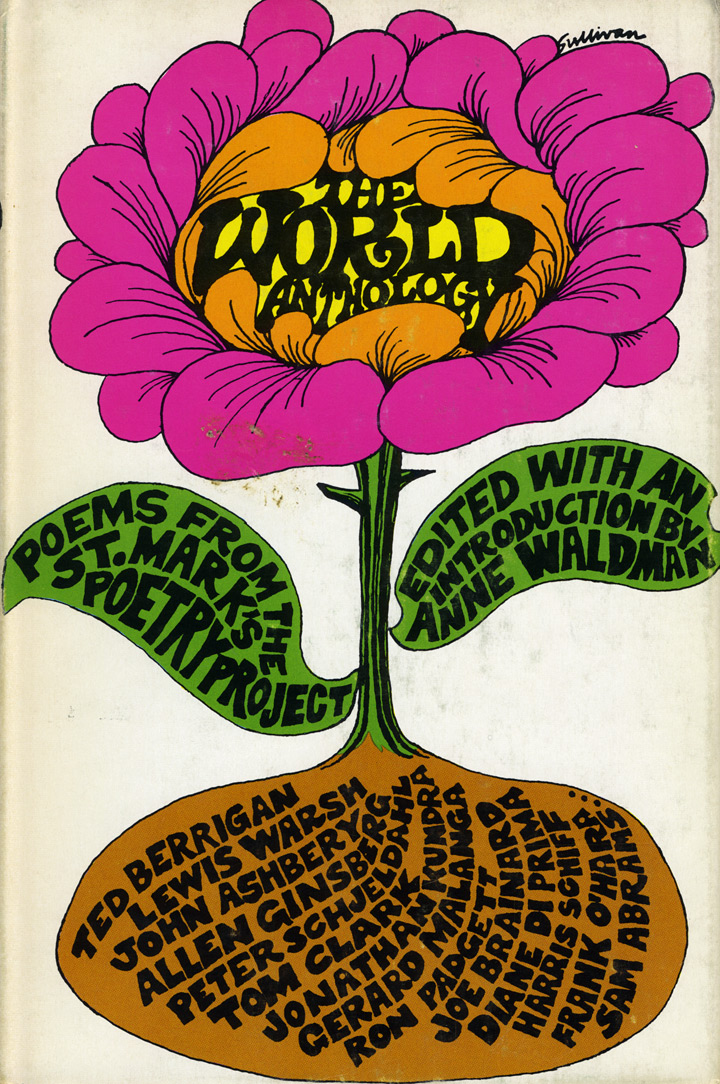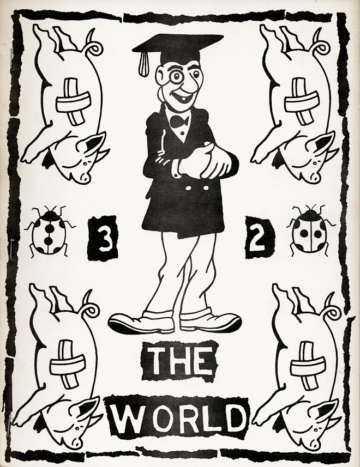The World
Edited by Joel Sloman, Anne Waldman, and others
New York
Nos. 1–58 (January 1967–2002).
Covers by Bill Beckman (7), Jack Boyce (5), Joe Brainard (9, 14, 25), Tom Clark (11), Fielding Dawson (6), Donna Dennis (4, 13), Bruce Erbacher (18), Larry Fagin (10), Cliff Fyman and others (41), John Giorno (22), Mimi Gross (26), Philip Guston (29), Louise Hamlin (36), Jean Holabird (33), Yvonne Jacquette (21), Alex Katz (28), Rochelle Kraut (35), Linda Lawton (31), Rosemary Mayer (45), Rory McEwen (27), Pat Padgett (24), Larry Rivers (30), George Schneeman (3, 8, 19), Rick Veitch (15), Tom Veitch (20), Britton Wilkie (23), and Trevor Winkfield (32), among many others.
Anne Waldman, ed., The World Anthology: Poems from the St. Mark’s Poetry Project (Bobbs-Merril, 1969).

In the Spring of 1966, I couldn’t wait to graduate from Bennington, and get back “home” (which meant Macdougal Street and subsequently St. Mark’s Place) and the “literary life.” I had edited Silo magazine at school, and Lewis Warsh and I had founded Angel Hair magazine and books at the Berkeley Poetry Conference in the summer of 1965. The fall of 1966 was a critical time for me with Frank O’Hara’s tragic death, but I was also hired as an assistant to the newly christened Poetry Project, a place where “only” poets could get jobs. Troubadour translator and New York poet Paul Blackburn had hosted open readings in the Parish Hall at St. Mark’s the previous year, after moving the scene from the Metro coffeehouse. Joel Oppenheimer, another poet, was named director. He had worked as a printer and wrote columns for the Village Voice in characteristic lowercase. Younger poet Joel Sloman, who’d been a protégé of Denise Levertov, came on as primary assistant. We were being funded by Lyndon Johnson’s Office of Economic Opportunity through a sociologist from the New School who had raised funding specifically to “benefit alienated youth on the Lower East Side.” He would interview the staff, the participants, do a “study.” So, a pilot project. We were “all” guinea pigs. We took the command seriously. When we started The World, there had been a lull in the little magazine blitz, di Prima and LeRoi Jones’s Floating Bear was subsiding, Ed Sanders’s Fuck You/ a magazine of the arts and “C” magazine, edited by Ted Berrigan, weren’t coming out regularly. Carpe diem! A not-so-efficient brainstorm as it turned out, Joel Sloman and I sent out stencils to our desired contributors in mailing tubes that were to be returned with hot-from-the-muse in-progress works.
They came back mangled, or improperly typed. Banged out in creative fervor. Holes for “o’s” from those with expressive macho typewriters. No, that sheet has to go under the blue part shiny side up, you dummies! Exasperation, but soon it started to look good in the tradition, as we in the Mimeo Revolution say. Long hours late at night in the office minding the machines. Then we’d have a collation party the next day with the heavy-duty stapler. The overinked pages had a certain charm. A page of an Edwin Denby play we printed, still readable but mottled, turned into a gorgeous work. George Schneeman often added color and visual flair to the magazine, and one of his works hangs over the peripatetic desk still. The other covers were fabulous! Artists Joe Brainard, Philip Guston, Yvonne Jacquette, Larry Rivers, Alex Katz, and others joined the mix. Joel’s issue number one included work by Jack Anderson, Ted Berrigan, Jim Brodey, Michael Brownstein, Ruth Krauss, Gerard Malanga, Joel Oppenheimer, John Perreault, Carol Rubenstein, Rene Ricard, Peter Schjeldahl, Anne Waldman, Lewis Warsh, Gary Youree, and others. I took over from Joel Sloman after the first issues, which had a number edited by Sam Abrams.
I think I was “in chief” by the end of 1967 and was then named director of the Project in 1968 and continued the magazine through the next decade, which included some fine guest editorships: Tom Clark, Lewis Warsh (the Prose Issue), Ron Padgett (the Translation Issue), to name a few. Bernadette Mayer was a stalwart coworker in 1974. The magazine was always too big, messy, uneven, democratic, inclusive, raw, and even boring at times. Hundreds of writers appeared in its 8½ x 11 pages. The impulse was always toward the immediate community, so it covers most of the so-called New York School plus what comes after, with a bow toward Black Mountain, the Beats, San Francisco Renaissance, and the New York Scene (not “school”), as well as many independent folk and younger writers from workshops. It was arty, political, experimental, classy, corny, unaligned. In 1976 or so after many issues, when I headed out West with Allen Ginsberg to start up the Jack Kerouac School of Disembodied Poetics at the Naropa Institute in Boulder, Colorado, the first thing I did was purchase a mimeo machine at a used office equipment store in Denver for $38 so I’d feel more at home.
— Anne Waldman, “Running off The World”

The World 32 (1979).
![The World 39 [1983?].](https://fromasecretlocation.com/wp-content/uploads/2016/09/the-world-no-39-1983-r-360x467.jpg)
The World 39 [1983?].
